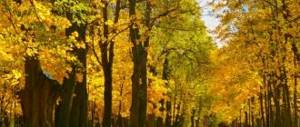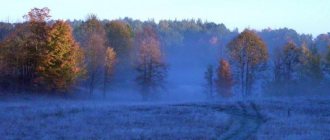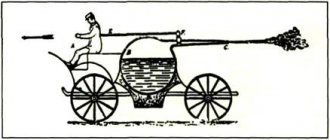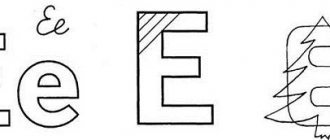“Winter in the Forest” Integrated lesson in computer science and natural history
in elementary school
Purpose of the lesson:
- Give children an idea of the life of the animal world in winter;
- Systematize and enrich knowledge about natural connections;
- Foster a caring attitude towards nature.
- Conduct a quiz “Guess whose footprint is in the snow.”
During the classes. I. Organizational moment.
The long-awaited bell is given, the lesson begins.
II. Updating basic knowledge. Teacher:
Our lesson today is unusual.
We will take a trip to a winter fairy forest. III. Generalization of background knowledge. Teacher:
Listen to the poem: The gray birch tree bent over, The snow crumbled into a white carpet.
Blue snowflakes fly and form a fluffy ball. Everything fell asleep: the dark hummocks, the river, and the trees in the forests. And the big frosty sun got lost in thick clouds. So winter has come, the forest has become cold, there is silence, the trees are bare. Only in the snow there are many, many footprints of someone: these are the tracks of animals. How do they survive in the forest in winter in such cold weather? Let's solve this riddle: The animal hid in a hollow, It was both dry and warm.
Stock yourself with so many mushrooms and berries that you couldn’t eat them in a year. Of course it's a squirrel!
The squirrel's house is a hollow in a tree. It is not very big, but dry. It is lined with moss and dry leaves, so it is warm there. She has several houses - one for sleeping, the other for wintering and for raising squirrels. It happens that in severe frosts several squirrels sleep in one nest, warming each other. And the entrance is covered with moss. Supplies are kept in a separate place. But very often other forest animals also feed on them. And here is another riddle about an animal that can be seen extremely rarely in the winter forest. Sleeping under a snag in a den….
as if in a house. He put his paw in his mouth and sucked like a little one. This is, of course, a bear.
In autumn, bears have a lot to worry about. First of all, they shed. Secondly, you need to take care of a reliable shelter where you can sleep peacefully until spring. And also accumulate fat reserves. And then go to sleep. But first he needs to cover his tracks. The bear wanders through the forest for a long time, jumps sideways from the trail and, making sure that the trail is well tangled, goes to bed. But he sleeps very lightly and restlessly. And the hedgehog does the same as the bear, it also hibernates until spring arrives: He is like a Christmas tree, covered in needles.
He boldly catches scary snakes, And although he is very prickly, Don’t you dare offend him! All animals hide from enemies, some in hollows, some in burrows under the snow.
But the hare doesn’t know how to do anything. There are plenty of enemies! He is helped by his nose, ears, legs and an inconspicuous fur coat: white in winter, gray in summer. Eyes are “slanting” - sees not only in front, but also to the side and behind. The ears turn completely sideways. The legs are fast. It feeds at night on branches and tree bark. He is good at confusing tracks. When running, puts the hind legs in front of the front ones. The people even made up a riddle like this: Run up the mountain, and somersault down the mountain. Behind the trees and bushes a flame flashed quickly. It flashed, ran, There was no smoke, no fire. Who is this, guys? That's right, fox! But foxes, by winter, also change their fur coat to a warmer and fluffier one. In fairy tales, the fox is the most cunning! But in fact, she is not at all more cunning than other animals. If it weren’t for his keen eyes, keen hearing and amazing sense of smell, the fox would not have found his prey - the field mice! The nose and ears help, it will find the mouse and jump. The mice get scared, run out, and then she scratches them! But it’s hard for her to catch a hare! Unless he accidentally collides or comes across a bunny. Physical exercise:
We are going skiing into the forest, We are climbing a hill.
The poles will help us walk, the road will be easy for us (Children wave their arms as if they are using ski poles). Continuation .
The gray wolf also loves to eat hare meat.
It’s cold for him in winter, that’s why he howls at night. And I don’t advise you to go into the dark forest, because a hungry pack of wolves is very dangerous. I want to encourage you to help poor animals! To do this, you need to hang feeders, create nature reserves, do not light fires in the forest, do not scatter garbage and do not set traps and traps in the forest. But most importantly, we need to protect animals from poachers. Unfortunately, poaching is currently developing on a large scale in most areas of our country. Neither fines nor confiscation of hunting weapons and equipment stop these terrible people. Poachers go to great lengths for valuable fur! But if every person thinks about this problem, then together we can protect our little brothers! IV. Consolidation of the material covered. Quiz: “Guess whose footprint is not in the snow!”
The guys look at the slides and guess the tracks of the animals.
The children know some of the tracks, but some they don’t, because they haven’t been in the winter forest. V. Summing up the lesson:
- What topic did we work on today?
- What new did you learn? — How can you help poor animals? - Evaluate your activities in class (reflection using emoticons). VI.
Homework: Write a short essay about how animals spend the winter in the forest in severe frosts.
· This educational resource is intended
· Goal:
—
formation of ideas about objects of the surrounding world;
Expanding children's understanding of seasonal changes in the life of wild animals;
Formation of rules for safe behavior in nature, respect for nature.
· Presentation
“How Animals Winter” can be used in educational activities with preschool children; it consists of 18 slides.
Preview:
ELECTRONIC EDUCATIONAL RESOURCE ON THE TOPIC
“HOW DO ANIMALS HAVE THE WINTER”
- Author-compiler: Anna Vladimirovna Goldina, teacher of GBDOU No. 85 of the Primorsky district of St. Petersburg.
- This educational resource is intended for children of senior preschool age.
- Goal: - formation of ideas about objects of the surrounding world;
Expanding children's understanding of seasonal changes in the life of wild animals;
Formation of rules for safe behavior in nature, respect for nature.
- The presentation “How Animals Winter” can be used in educational activities with preschool children and consists of 18 slides.
- Content:
- Title page.
- Pictures “Forest in late autumn” (day and night)
- Pictures “Bear”, “Bear’s den”
- Pictures “Hedgehog”, “Hedgehog winter quarters”
- Pictures “Badger”, “Badger Hole”
- Pictures “Beaver”, “Beaver hut”
- Pictures “Squirrel in summer”, “Squirrel in winter”
- Picture “Squirrel hole in winter”
- Pictures "Vole", "Vole's Hole"
- Pictures “Lynx in summer”, “Lynx in winter”
- Pictures “Hare in summer”, “Hare in winter”
- Pictures “Fox in summer”, “Fox in winter”
- Pictures “Wolf in summer”, “Wolf in winter”
- Picture "Wolf Pack"
- Pictures “Moose in summer”, “Moose in winter”
- Pictures “Sable in summer”, “Sable in winter”
- Pictures “Garden Dormouse in Summer”, “Garden Dormouse in Winter”.
- Pictures “Bat in summer”, “Bat in winter”.
Working with a presentation. Teacher's comments.
Slide 1.
What time of year is approaching us? That's right, winter! We're now in late fall and getting ready for winter, right? How can we humans prepare for it? (We buy warm clothes, prepare supplies for the winter, insulate our houses, close up the windows, etc.). Guys, do you know that animals living in forests prepare for winter almost the same way as we do! They also make edible reserves, insulate their burrows, exchange their summer skins for winter ones, and some animals even spend the entire winter in deep sleep! Today we will talk to you about how different animals prepare for the coming of winter. In winter, many wild animals sleep - hibernate. During hibernation, they do not eat anything, do not grow, and do not respond to sounds.
Before hibernation in the fall, animals accumulate fat. Fat helps them maintain body temperature during long hibernation - it “warms” them from the inside like a stove.
Slide 2.
In late autumn, the forest seems to fall asleep. The chirping of birds could not be heard, with the onset of cold weather insects disappeared, the grass withered and withered. The animals have been preparing for the onset of cold weather since the summer. Life in the forest continues.
Most of all, animals suffer in winter not from cold, but from hunger. It is food that animals need to maintain a constant body temperature and not die. In search of food, wild animals can travel long distances and even go to people’s homes. Is it possible to approach a wild animal you encounter? (No, why? (Can bite, can carry dangerous diseases) What to do if you accidentally see a wounded wild animal? (Tell adults, they can call the wild animal assistance center)
Slide 3.
Bears set up their home in advance. They look for caves, ditches, where they carry leaves, branches, moss, and make a soft mattress on top from spruce branches. When snow falls, it masks the bear's hiding place and keeps it warm. Bears do not store food, but in the fall they actively feed on nuts and fish in order to accumulate as much fat as possible for the winter. In fact, the predator does not sleep, but dozes, and if necessary, it can leave the den. It is in winter that a mother bear gives birth to small cubs.
Slide 4.
When it gets cold, hedgehogs need to accumulate fat, and in the fall, hedgehogs have little prey. Worms hide in the ground, nimble lizards hide. It's hard to find bugs and frogs. On clear autumn days, the hedgehog prepares a warm nest for wintering. Night and day, it drags dry leaves and soft forest moss into the hole. The hedgehog spends more than six months in hibernation. During this time he does not eat anything or move. He sleeps curled up in a ball, in a den, under a deep snowdrift, as if under a thick, fluffy blanket. And he sleeps like this all winter, until the spring sun.
Slide 5.
Winter is a difficult period in life for badgers; they do not tolerate low temperatures well. At the beginning of autumn, badgers prepare housing and collect food for the winter. In order to survive the winter, they equip their burrow with grasses, branches, moss, etc. From food they stock up on nuts, acorns, plants, seeds, etc. They are sensitive to frost. They spend the winter passively in the burrow, eating supplies.
Slide 6.
Beavers prepare their homes in advance. They can place it at water level or underwater. To do this, they take down sticks and branches, which are masterfully tied with seaweed, grass or held together with clay. The house built by beavers under the ice is warm and safe. They do not freeze in water in winter because their fur coat is waterproof. Beavers pre-prepare their food for the winter. In winter, they do not hibernate, but reduce their activity, while feeding on food.
Slide 7.
Squirrels prepare for winter throughout the year. They stock up on nuts, acorns, mushrooms, berries, and pine cones, as they feed only on plant foods. They carefully dry the obtained food on branches and stumps and store it in their home. Squirrels overwinter in hollows, but do not hibernate. They do not tolerate frost well, so they spend most of the winter in their houses. Squirrels equip the hollow in advance with tree bark, moss, found feathers, etc. In winter, squirrels change their color from red to grayish for camouflage purposes.
Slide 8.
This is what a squirrel's hole with winter supplies looks like.
Slide 9
Many voles also greet winter interestingly. These cute mice begin to harvest grass in the spring, putting it in small piles under certain shelters (for example, under stones). In summer, voles bring rosehip flowers, leaves, cones and pine needles there. The active activity of these creatures ends in the fall, when the first snow covers the mountain meadows. One family of voles can store from 5 to 10 kg of food!
Slide 10.
Lynx does not hibernate. Among all representatives of the cat family, the lynx is best adapted to cold weather. She moves excellently in deep snow and climbs trees. Favorite prey of lynxes are hares, black grouse, and hazel grouse. Sometimes she attacks young wild boars; in a hungry winter, she can feed on small rodents. In winter, moose especially suffer from lynxes, when it is difficult for these long-legged animals to move through deep and loose snow. By winter, the lynx's fur becomes thick, fluffy and soft, and the lynx's paws are heavily furred so as not to feel the cold.
Slide 11
Hares do not set up burrows and do not store food for the winter. They endure severe frosts on their paws. As a camouflage, starting in autumn, hares change color from gray to white. This gives them the opportunity to camouflage themselves from predators against the backdrop of snow. Well, if a wolf or fox notices him, he quickly tries to escape. Winter behavior also includes digging temporary holes in snow or hay. In such burrows he rests and gains strength.
Slide 12.
Preparation for winter for a fox begins with insulating its fur coat. Her fur becomes thick, fluffy, and bright. It perfectly protects the fox from severe frosts. Foxes live in burrows all year round. Often the place for digging a hole is some kind of hill so that the fox can view the entire forest. If she has moved far from her hole and a strong snowstorm begins, the fox may temporarily settle in another abandoned hole. Before returning to the hole, she carefully covers her tracks. The fox does not stock up for the winter, but regularly goes hunting. Its prey most often are rodents. In the absence of meat, she can eat berries or vegetables found. Nature has it this way that in winter, foxes have a reduced metabolism. Subcutaneous fat is wasted on keeping them warm in severe frosts. Fluffy paws allow foxes to move silently when hunting prey. The fox is resistant to severe frosts.
Slide 13.
Wolves are the most dangerous forest predators. Their fur becomes thick and long in winter. This coat helps the wolf withstand the winter cold. And even in severe frosts, a wolf can sleep in the snow, covering its nose with its fluffy tail. As soon as it starts to get dark, the wolves go hunting. Wolves travel very long distances in search of food. Sometimes many tens of kilometers. They hunt animals of any size alone or in a pack.
Slide 14
In a pack, wolves easily catch prey within a radius of 30-60 km, then eat it together. On average, a pack consists of 7-12 wolves. The coordinated actions of the entire pack help wolves survive in winter.
Slide 15.
Moose live in forests. Closer to autumn, when the berries of lingonberries and blueberries ripen, the elk likes to eat them directly with the twigs; he also loves mushrooms, even looking for them specifically. In winter, moose gnaw the bark of aspen, rowan and willow trees. At the end of autumn it sheds its antlers, and by spring it grows new ones. He is not preparing a permanent home. It is difficult for them in winter, when the snow floor is very deep, because it is not easy to cross it with such long legs.
Herbivores can have a very bad time in winter, especially if there is a lot of snow. Overwinter for moose, deer, etc. Foresters help. They store hay in the summer, and in the winter they place feeders with hay and branches in the forest - animal “canteens”.
Slide 16.
The sable is attached to a certain territory. Going somewhere tens of kilometers away from your “hunting ground” is not in the rules of this animal. The sable nimbly climbs trees, but prefers to live and hunt on the ground. In winter, he does not like to move in the snow. The sable has excellent hearing - when it hears the squeak of a mouse, it dives into the snow and deftly finds and grabs its prey under the snow.
Slide 17.
Before the onset of cold weather, forest dormouse begin to noticeably gain weight. They get fatter until they weigh a couple of times more than usual and look like a small fur bag. These creatures sleep in spherical nests, made by them specifically for wintering. At least they are active in some way! Zoologists are touched by the sight of a sleeping forest dormouse: the rodent curls up into a very tight ball, pressing its nose and small paws to its abdomen. At the same time, the fluffy tail, in a semi-ring, covers almost the entire body of the animal.
Slide 18.
Destroyers of harmful insects - bats - disappear from our sight in the fall. With the onset of cold weather, some of their species fly to warmer, southern regions, flying many kilometers. But the long-eared bats, bats and noctules remain in place and hibernate. Animals look for convenient shelters, huddling in a crack or securely attaching their paws to ceilings or walls, hanging upside down. The shelter must be securely hidden and without drafts. The temperature in it ranges from 7-8 0 C with a humidity of 80 - 100%. These can be deep wells, dungeons, basements, caves, mines and adits, attics and hollows of old trees.
When compiling the EUR, pictures and texts from the Yandex search service were used.
To use presentation previews, create a Google account and log in to it: https://accounts.google.com
Slide captions:
Presentation on the topic: “How animals winter.” Educator of GBDOU No. 37 Emelyanova N.I. November 2020
The first animal that we will talk about today is the owner of all forests - the bear. What do you know about him? (children's answers) The bear's main food is berries, nuts, roots, bulbs, ants, beetle larvae and fish. This helps him accumulate fat for the winter. Brown bears make their den in a hidden, inaccessible place. Most often, it is under the root of an upturned tree or in a windfall. In November, the bears climb there and fall asleep. Bears sleep restlessly. If they are disturbed by something, they can abandon the den and build another one. In a mother bear's den, cubs are born, usually 1-2, rarely 3. They are very small, the size of a mitten. Mother bear feeds them milk for 8 months. and even when she sleeps in winter.
The next animal we will talk about is the lynx. Lynx does not hibernate. Among all representatives of the cat family, the lynx is best adapted to cold weather. She moves excellently in deep snow and climbs trees. Favorite prey of lynxes are hares, black grouse, and hazel grouse. Sometimes she attacks young wild boars; in a hungry winter, she can feed on small rodents. In winter, moose especially suffer from lynxes, when it is difficult for these long-legged animals to move through deep and loose snow. By winter, the lynx's fur becomes thick, fluffy and soft, and the lynx's paws are heavily furred so as not to feel the cold.
Hare. As we know, before the onset of winter, the hare changes its gray skin to white. In winter they feed on bark, small twigs of aspen, willow, and birch. In winter, a fallen tree can become a real hare's dining room, where the animals visit every day until they gnaw off all the bark. They have no permanent home. In extreme cold, they hide under snow-covered bushes.
Hedgehog. When it gets cold, hedgehogs need to accumulate fat, and in the fall, hedgehogs have little prey. Worms hide in the ground, nimble lizards hide. It's hard to find bugs and frogs. On clear autumn days, the hedgehog prepares a warm nest for wintering. Night and day, it drags dry leaves and soft forest moss into the hole. The hedgehog spends more than six months in hibernation. During this time he does not eat anything or move. He sleeps curled up in a ball, in a den, under a deep snowdrift, as if under a thick, fluffy blanket. And he sleeps like this all winter, until the spring sun.
Squirrel. Many rodents also make winter reserves. Squirrels, which sleep in winter only in very severe frosts, need capital reserves. Unlike many other animals, squirrels use their reserves together. In the fall, they hide acorns and nuts in the forest floor, in hollows, and in the ground. Not only the owner herself, but also any other squirrel can get them from there. They also store mushrooms in a special way: they string them on tree branches or stuff them into forks between the branches. By winter, the coat of this animal becomes very soft and fluffy, and the color is grayish. She builds her nest on tall spruce or pine trees. Inside the nest there is soft grass, moss, and balls of wool. In severe frosts, the squirrel does not crawl out of its hollow, and may even fall asleep.
Presentation on the topic “Winter Forest” Project
Slide text: It is curious that in the countries of the Far East, winter mushrooms are bred, and they are used not only for food, but also for the preparation of medicines. I have come across references in the literature that the mushroom has pronounced antiviral properties and even inhibits the growth of cancer cells. Much less often in the forest you can find the sulphurous honey fungus, which prefers to settle on the stumps and dead wood of coniferous trees. Despite the name, the mushroom is edible and tasty. It differs from the winter honey mushroom in its more faded color, which can vary from yellowish-gray to brown. With age, the plates of the mushroom noticeably darken, turning from whitish-yellow to grayish-blue. If you rub a piece of the cap between your fingers, a pleasant mushroom smell appears. It’s not for nothing that I mention the smell. The poisonous mushroom, which can also be found in the winter forest, is a bit similar to the sulfur-plated false honey fungus. This is a sulfur-yellow false honey fungus. It has bitter pulp and an unpleasant odor. In addition to this, among the inedible mushrooms in the forest you can find the winter tinder fungus. Unlike most tinder fungi, it looks like a “normal” mushroom on a stalk with a dark gray or brownish cap. The edges of the hat have a small fringe. Under the cap there is a white or light cream very short tubular layer (the main difference). The flesh of the mushroom is tough, but not poisonous. Of the inedible mushrooms, the main value in the winter forest is birch chaga. It is difficult to confuse it with something; these are large black growths that grow in breaks in the bark of old birch trees. They can reach significant sizes and weigh several kilograms. Chaga has pronounced antiseptic and antimicrobial properties; it contains substances that are natural biogenic stimulants. Chaga preparations strengthen the immune system, increase the body's protective properties, stimulate the central nervous system, and improve metabolism. When going into the winter forest to pick mushrooms, keep in mind that you won’t need an ordinary penknife to cut them. You need a large, strong knife, and in some cases a small hatchet. In any case, it will not be possible to “chop off” the chaga without an axe. Since winter mushrooms can grow to considerable heights, you may need a long stick with a pointed end. Naturally, clothes should be chosen according to the weather. Despite the frosts, the winter forest is ready to please mushroom pickers with tasty and healing finds. If you are unlucky in finding winter mushrooms, then a walk through the snowy forest will still leave a pleasant impression and help you recharge your batteries.
Interesting things about winter mushrooms






